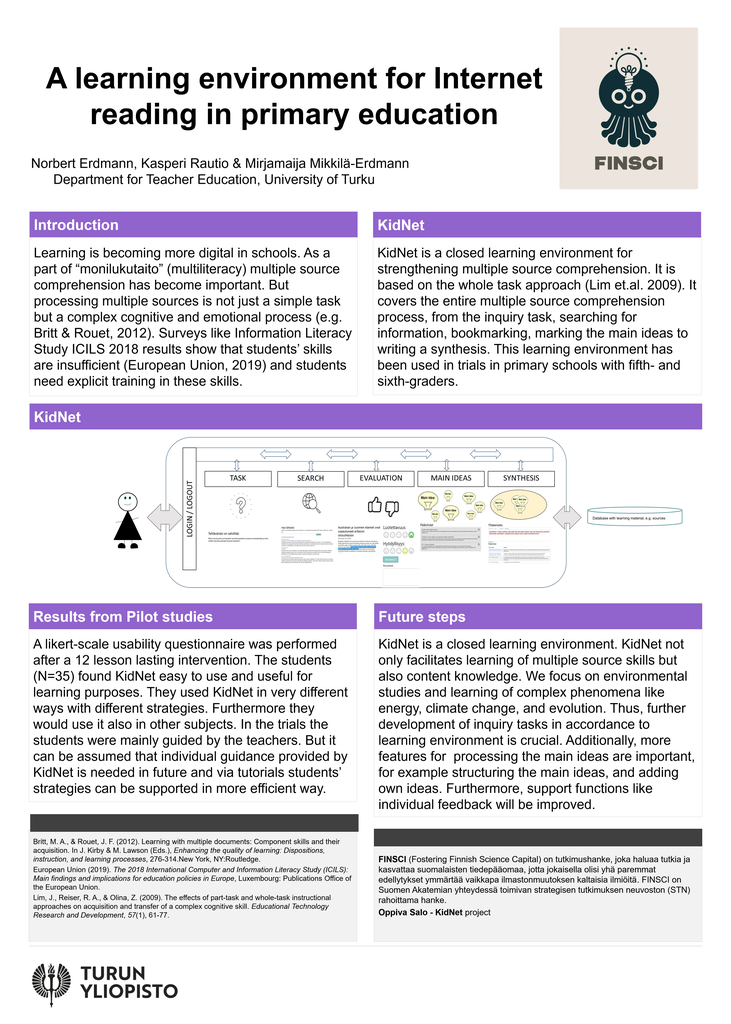-
Digitaalinen lukutaito kodin ja koulun voimavarana
Lehtonen Daranee
-
iPad monipuolisesti ja luovasti
Koivumaa Simon
-
Oppimismuotoilun työpaja
Laapio Isto
-
Learning environment supporting new ways of learning, insights from user surveys
Peltonen Hannele
-
Anni Autere-Kesti
Autere-Kesti Anni
-
Oppilas- ja opettajaportaalit osana sujuvampaa arkea
Mehtälä Karri
-
Digital self-assessment - A roadmap to student engagement
Pirkko Ala
-
Helsingin verkkolukio
Lähde Markus
-
Psykologisen turvallisuuden rakentaminen verkko-opintoihin
Mattila Johanna
-
Koulujen ja huoltajien materiaalipankit
Juutinen Saara

Poster in pdf format
Learning is becoming more digital in schools. Thus, the students have not only to learn to handle new devices but also new environments like the Internet. In contrast to a textbook with a certain content written in a certain style, the Internet offers many different sources with many different types of texts. Thus, the student have to search for information appropriate to the task, to evaluate and select sources, and to combine several sources to write an answer. This processing and learning from multiple sources has become both, a field
of research which offers various behavioural and cognitive models (Mason, 2018),
and furthermore a part in many western curricula, even in primary education (Finnish
curriculum, 2016). However, recent studies indicate
that students’ skills of multiple text comprehension are insufficient (e.g.
Kiili, Leu, Marttunen, Hautala, & Leppänen 2017; Sormunen & Lehtiö
2011) and explicit training in these skills are requested. (e.g Leu et al,
2017, ; Sormunen & Alamettälä, 2014). Additionally, there seems to be a gap
in pedagogical practices, how teachers teach online skills in everyday
classroom.
We present a learning environment for learning Internet skills. The closed learning environment for strengthening multiple source comprehension is based on the whole task approach (Lim et.al., 2009). It provides the entire multiple source comprehension process, from the inquiry task, searching for information, bookmarking, marking the main ideas to writing a synthesis. This learning environment has been used in several trials in school with fifth- and sixth-graders. We present the concept of the prototype and some preliminary results concerning the trials.
The closed learning environment contains creates simplified learning conditions. It contains several tasks and many sources of which only a few are relevant for the answer to the respective task. The student can use a search engine with a SERP (search engine result page), a possibility to bookmark and evaluate sources concerning usability and credibility, and a clipboard to mark, copy and structure the main ideas of each sources. Furthermore, it provides a word processor to write the answer for the task with the help of the main ideas of the clipboard.
Preliminary results indicate that the learning environment was perceived as useful with a good potential for further development to complement learning material like e-textbooks in the future.